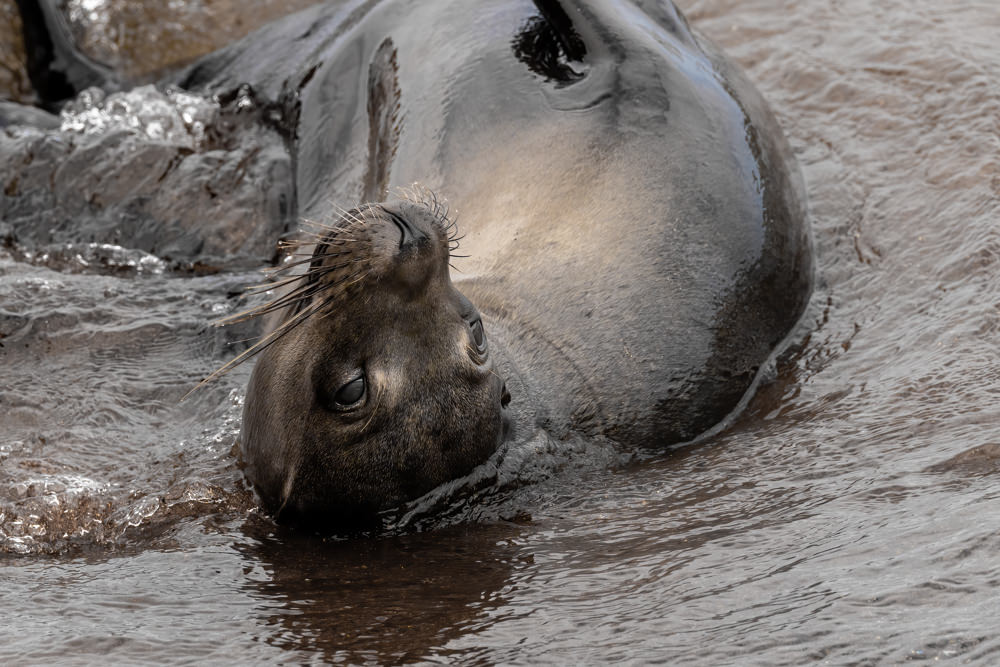“Don’t step on the iguana!”
And with those words, Cindy and I arrived at the Galapagos Islands for 10 days of truly incredible vistas and encounters with wildlife. It turns out that Ecuador is pretty much a straight shot down from St. Louis, but you wouldn’t know it from the route that the three airplanes took to get to San Cristóbal Island and back. As is the case so often, the travel part was the least fun.
I am not, by nature, a person into recreational water sports, but many years ago, I had taken up scuba diving. That part of my life has not resurfaced, but the snorkeling opportunities in the Galapagos were too enticing to turn down. So, I went whole hog and got my own mask and snorkel, fins (which wound up being too small), and full-length wet suit. As the rainy season approaches at the equator, the water temps are a tad too cool for me.
This was a different kind of trip than others we have taken. Every day of our cruise included activities, some of them just a little too strenuous for my blood, but Cindy relished all the opportunities to take photos with what is turning out to be a camera collection to rival the one for shoes. That’s not true, but her photos are of the highest quality, and at the end of this, I will share some of them with you.
The chef on board the Silver Origin was excellent and even gave a class on how to make proper ceviche. It’s not all that difficult. All the naturalists (they kept their clothes on) were outstanding, and I now know way more about the differences between seals and sea lions than I could have ever imagined.
It was a wonderful adventure, and I had musical ones this month, as well.
One of the pleasures of freelance conducting is the ability to work with orchestras that I have never conducted before. The first one of these engagements for the new year was in Spokane, Washington. A few years ago, after attending an opera in Toronto, I was at a post-performance dinner with Tom Hampson, who starred in the work. He asked me if I would consider coming to this orchestra, as Spokane is his hometown. I said yes, and after a two-year delay due to Covid, it finally materialized.
Not only had I never led the orchestra before, but I also had never visited the city. People who say it rains all the time in Washington would appear to be correct, as the wet weather, although not as bad as in California right now, was a dominant feature of the climate. It made for a very dreary-looking place. The hotel was right across the street from the hall, a converted Fox movie theater. I could look out the window and see my name plastered across the moving billboard.
In an interview with the Spokesman-Review, I was referred to as “America’s Greatest Conductor.” There are a couple people who might disagree with that. My wife, whose piece Double Play was on the program, had her last name reduced to Tee in the story. If she writes a duet, will it be called “Tee for Two?”
When you know nothing about an orchestra and are going to lead it for the first time, the choice of program is paramount to making the experience workable. I try to select pieces that are suitable for most orchestras and not necessarily on the radar all the time.
I have done Cindy’s work with a number of groups, and as long as I have enough rehearsal time, it always goes well. The same can be said of Tchaikovsky’s Francesca da Rimini, a work I adore but do not get to perform very often. It is tricky to program because it is 25 minutes long—too lengthy to open a concert and too short to end one. However, it is perfect to conclude the first half, especially if the program does not include a soloist.
The first rehearsal found the Spokane Symphony easily up to the task of performing Brahms’s First Symphony, the masterwork on the second half of the program, making me feel more than comfortable about what the end result would be. The acoustics of the hall are a bit dry, but the players can hear each other well.
Clearly the musicians came prepared and willing to work hard for this program. As each rehearsal progressed—and there were five of them—we began to forge a strong bond, and it was clear that the concerts would be presented on a very high level.
As with so many performing organizations, the Spokane Symphony was hit hard during the pandemic. The city has a population of about a quarter of a million people, and if you add in the surrounding areas, perhaps twice that. But many are still reluctant to venture out to entertainment venues. What makes this more problematic is the lack of large corporations to lend financial support, so it is the individual donors and ticket buyers who have to take up the slack. Nevertheless, we had almost-full houses for the two performances, an encouraging sign for the orchestra’s future.
I found the people who work in the administration to be very gifted, forward-thinking, and willing to listen to new ideas. Hopefully some of the possibilities we discussed during my time there will come to fruition. Each city has its own difficulties, and solutions that work in one place do not necessarily apply to another.
There were numerous events crammed into the schedule, all of which were made a bit difficult when I came down with a bad cold, resulting in laryngitis. This is an orchestra’s dream: a conductor who cannot talk. In any event, all went well, with very enthusiastic audiences and outstanding playing from everyone.
I spent the last week of January at Yale, but because the timing almost overlapped with my brother’s memorial service, I have decided to save my recap of that experience for the March journal entry. In the meantime, I leave you with the next movie review from my new job as a film critic, as well as some of the amazing pictures Cindy took on the Galapagos trip.
***
How Do You Get to Carnegie Hall?
On paper, it looks like one of the greatest musical galas every held. Think of it—Heifetz, Rubenstein, Reiner, Walter, Pons, Piatigorsky, Stokowski, and Peerce, as well as other musical luminaires, all together on one stage. Well, it didn’t happen, but there they all are, at some point, in the 1947 film Carnegie Hall. I remember seeing it a couple times, once when I was quite young and then as part of a film component of a summer festival I founded in Minneapolis.
The so-called Golden Age of Hollywood was in full swing, and almost every studio made at least one film in which classical music was the impetus for interesting screenplays. This was not one of them. In fact, the story is so lame that you wish they would get rid of most of it and just let the performers do their thing. In this particular case, despite the starry array of musicians, the film fell into a category known as the “B-movie.” Somewhat akin to the second side of a single record, it might have been shown as part of a double bill, when they still had those.
The actors were decent enough but never the top stars, so they were hardly a box office draw. For this effort, Federal Films turned over the directing job to Edgar G. Ulmer, who specialized in low-budget movies. And the project itself was aided by the fact that Fritz Reiner was the godfather of Ulmer’s daughter.
There really is not much you need to know about the plot. Stage mother doesn’t like her piano-playing son doing gigs with big bands, which leads to an estrangement. Mom works at Carnegie as a cleaner and winds up booking artists. Really, that’s about it. You can figure out the ending without my help.
But when those opening credits roll, it is quite something to see the cavalcade of classical celebrities of the time. Near the end of the cast list, we see the name Vaughn Monroe, a crooner and band leader, and this foreshadows what is going to happen before one frame of the actual film starts.
Other interesting tidbits include learning that some of the orchestrations and original music were done by Russell Bennett. Notice that the Robert is omitted, for those of you who are familiar with his Porgy and Bess: A Symphonic Picture. The music director of the original music for the film is Charles Previn, a cousin of André. He is credited here as the music director of the Radio City Music Hall Orchestra. We also learn that five different pianists were utilized for various sequences.
And in one scene, we see one of these pianists—Nadia Reisenberg, playing the Schumann Piano Quintet with members of the New York Philharmonic, including John Corigliano Sr. and Leonard Rose. Pretty impressive.
When the film begins, it is 1920. A young pianist is rehearsing the last movement of Tchaikovsky’s First Concerto, and it is not going well. The conductor, Walter Damrosch, played in this scene by an actor but later in the film by Damrosch himself, wants to impose his will and be boss in the piece. The soloist, Tony Salerno Jr., stomps out and, in a twist I have never seen before, gets replaced by a member of the string section. Good luck with that. We get a reminder that Damrosch gave the first concert at Carnegie Hall years earlier and had Tchaikovsky conduct a couple pieces.
There is also a wonderful reference, which only a few will get, when another conductor remarks, “de Pachmann should have heard this.” You can look this up.
As we move through time, we see posters of other great artists who have appeared at Carnegie Hall, including Rachmaninov, Kreisler, Lehmann, and even their managers. At one point, our heroine (sort of) is late for a concert and is admonished with the line, “Bruno Walter won’t wait for us.” Throughout the film, the orchestra we see is indeed the New York Philharmonic, but in the early sequences with Damrosch, it is called the Symphony Society of New York, a kind of rival.
Among the musical gems are a sensational “Bell Song” with Lily Pons and Piatigorsky playing “The Swan,” accompanied by six harps! Rubinstein plays a Chopin Polonaise and his signature “Ritual Fire Dance,” complete with the arms raised all the way up. Jan Peerce, who is in the middle of giving a lesson, belts out “O Sole Mio,” and Ezio Pinza, who would later star in South Pacific, sings an aria from Don Giovanni. Olin Downes, the chief music critic for the New York Times, even makes an appearance.
But of course, the greatest accolades go to the combo of Heifetz and Reiner, in about a 12-minute chunk of the Tchaikovsky Concerto. This includes the violinist’s interpolations of some finger-breaking thirds just before the tutti section in the middle as well as the end of the movement. Surprisingly, there are a few moments when the sense of ensemble threatens to fall apart, but these are quickly resolved.
Hearing and seeing the various musicians acting reminds us of why they kept their night jobs. I found a few other items interesting. All these years I spent in New York, I never knew that originally, there was a pharmacy on the corner. Carnegie Hall closed down for the summer to allow the interior scenes to be shot, replete with extras as audience members. And for all the performances, the basses (six of them) are in a row on the back wall, but the cellos start off next to the first violins and are later seen on the outside right of the conductor.
I do wonder how much time it took them to get the correct backlighting to make Stokowski’s hair appear ethereal.
So Carnegie Hall the movie will probably not have a sequel. It is not easy to find a copy, but there are a few versions of it on YouTube. Take a look, but fast forward to the performances.
I give it one Golden Baton for the story and acting, but four for spectacular music-making, save for the two out-of-tune numbers by Vaughn Monroe.
***
***
***
***
***
See you next month,
Leonard




